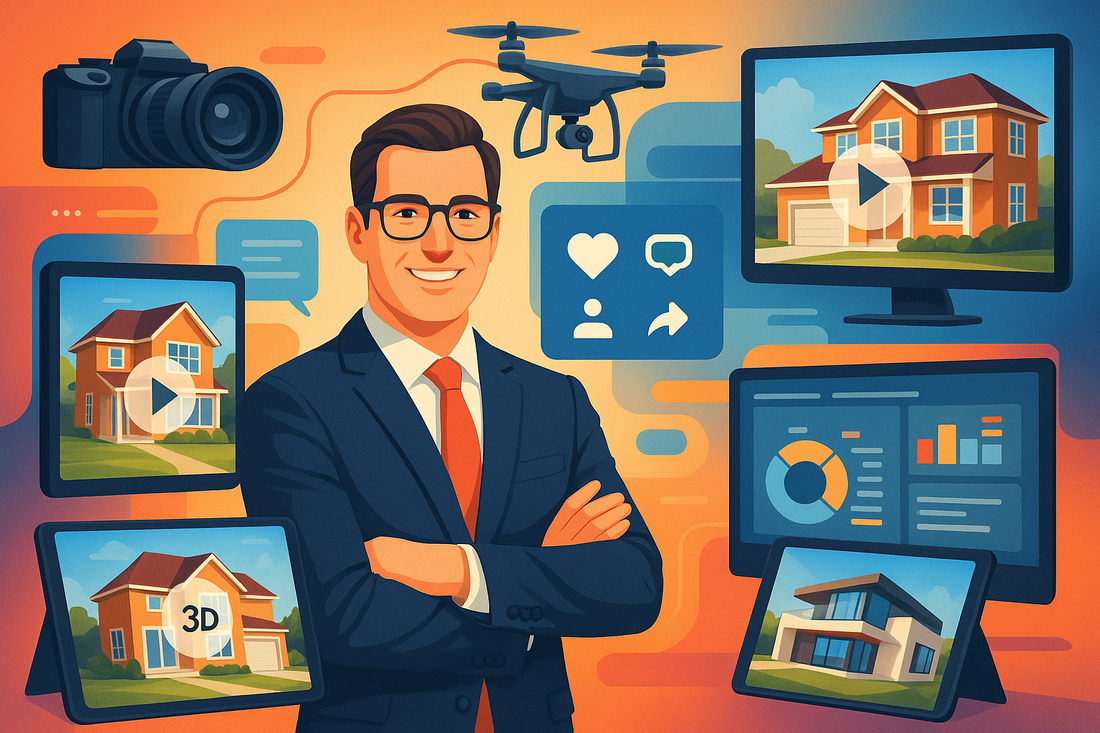
Why Every Real Estate Agent Needs a Media-First Marketing Strategy
Share
The real estate industry has undergone a dramatic transformation in recent years. Buyers no longer rely solely on newspaper ads, open houses, or even static online listings. Today, decisions are made in seconds, often based on the first impression a property creates online. In this landscape, traditional marketing approaches are no longer enough. To stand out and succeed, real estate agents need a media-first marketing strategy—one that places high-quality visuals, immersive content, and digital storytelling at the forefront of every listing.
What Is a Media-First Marketing Strategy?
A media-first marketing strategy prioritises visual and interactive content over text-heavy descriptions or passive advertising. It leverages photography, video, virtual tours, 3D walkthroughs, drone footage, and social media to create an engaging, immersive experience for potential buyers.
Rather than thinking of media as a supplementary tool, media-first strategies make it the primary way properties are marketed, capturing attention and driving engagement before buyers ever step inside.
Why Media Matters More Than Ever
1. Online First, Physical Later
With over 90% of buyers beginning their search online, the first impression of a property is digital. High-quality images, 360° tours, and video content immediately communicate the property’s appeal, helping buyers decide whether to pursue it further. A poor digital presentation can turn away potential buyers before they even schedule a viewing.
2. Attention in a Crowded Market
The average buyer scrolls through dozens of listings in minutes. Properties with engaging media—videos, aerial shots, or virtual staging—stand out in feeds and search results. A media-first approach ensures listings are eye-catching and memorable, increasing the likelihood of inquiries.
3. Emotional Connection Through Storytelling
Real estate isn’t just about square footage and amenities—it’s about lifestyle. High-quality media allows agents to tell a story, showcasing how spaces can be lived in, styled, or enjoyed. Video walkthroughs, drone shots, and virtual staging help buyers visualise life in the property, creating emotional engagement that drives faster decisions.
Key Components of a Media-First Strategy
1. Professional Photography
Clear, high-resolution photos remain the foundation of any property listing. They communicate professionalism, highlight key features, and ensure the listing stands out.
2. Video Tours and Walkthroughs
Video allows buyers to see how spaces flow and appreciate the property’s full potential. Cinematic tours and narrated walkthroughs provide immersive experiences that photos alone cannot deliver.
3. Virtual Staging
Digital staging transforms empty or outdated spaces into modern, inviting environments. This cost-effective tool enables multiple design styles without physical furniture, appealing to a wider range of buyers.
4. Drone Photography and Videography
Aerial shots showcase the property’s scale, surroundings, and neighborhood. Drone footage adds a sense of grandeur and perspective that engages buyers immediately.
5. Social Media Integration
Platforms like Instagram, TikTok, Facebook, and YouTube are ideal for distributing media-rich content. Social campaigns amplify reach, attract qualified buyers, and build the agent’s brand simultaneously.
6. Interactive Media
3D walkthroughs, virtual tours, and AR/VR experiences allow buyers to explore the property at their own pace. This interactivity deepens engagement and increases buyer confidence.
Benefits of a Media-First Strategy
-
Faster Sales: Engaging media attracts attention and shortens the decision-making process.
-
Higher Sale Prices: Listings with high-quality visuals often sell for more, as buyers perceive greater value.
-
Better Lead Quality: Media-first listings attract serious, qualified buyers who are ready to act.
-
Agent Credibility: Professional, polished marketing enhances the agent’s reputation and trustworthiness.
-
Cost Efficiency: Digital media reduces the need for repeated in-person showings and traditional staging costs.
Real-World Impact
Agents who adopt a media-first approach report higher engagement metrics, faster inquiries, and a significant reduction in time-on-market. For example, homes with video tours and virtual staging often receive three times more online views than those with photos alone. Social media amplification further extends reach, connecting with both local and international buyers.
The Future of Real Estate Marketing
As technology evolves, media-first strategies will continue to dominate. AI-generated virtual tours, interactive AR experiences, and immersive VR walkthroughs will become standard expectations. Buyers increasingly demand rich, interactive content that helps them make informed decisions without the limitations of physical visits.
For agents, embracing a media-first mindset is no longer optional—it’s a competitive necessity.
Final Thoughts
In today’s digital-first real estate market, media is the most powerful tool an agent has. From high-quality photos to interactive virtual tours, every visual touchpoint is an opportunity to capture attention, build trust, and drive sales.
A media-first marketing strategy ensures that properties not only look their best but also connect emotionally with buyers, generate qualified leads, and close faster. For real estate agents, it’s the key to staying ahead in a market where first impressions are made online and every click counts.
